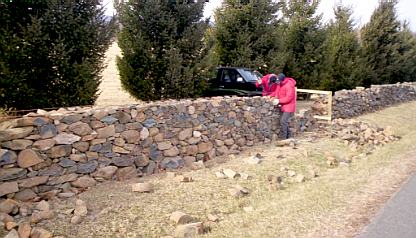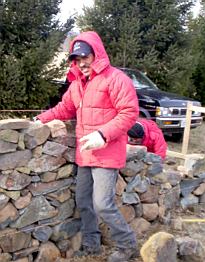
We’re back. The Baron’s friend, who was the oldest of eleven children and much beloved by them all, was buried today. Afterwards, the very large family and the old gang — who aren’t exactly old yet, but are well on their way — gathered to talk about childhood memories. I felt badly for Mr. S., the grieving father. At any age it’s hard to bury your children, but at eighty-one, burying your oldest son is particularly rending.
On the way south, we went through horse country. There are acres and acres of smooth pasture, rolling on to the Blue Ridge Mountains in the far distance. Houses hide behind long drives or, in the case of the really old ones still extant, sit right on the road. No asphalt back in the 18th century.
Many of the old houses are built of local stone, and there are low stone fences everywhere. These are the fruits of the field, gathered over the years when those fields were actual farms and the rocks were impediments to plowing. In some ways, it looks like New England here, but a gentler version. Less flint, more quartz, perhaps.
 We stopped to talk to two Mexican immigrants who were rebuilding the crumbling walls of one estate. The more extroverted of the two, whom you can see standing outside the wall, has been in the U.S. for four years. He likes it here, but the cold bothers him. When told that his English was good, he laughed and said he had attended night school for ESL classes.
We stopped to talk to two Mexican immigrants who were rebuilding the crumbling walls of one estate. The more extroverted of the two, whom you can see standing outside the wall, has been in the U.S. for four years. He likes it here, but the cold bothers him. When told that his English was good, he laughed and said he had attended night school for ESL classes.
He asked if we minded having so many Mexicans in America. I said the problem wasn’t the legal immigrants, it was the ones who came in illegally and were worked very hard for little money. “It robs them and it robs the country.”
His face got serious and he said he believed Mexicans could stay in Mexico if it weren’t for the corrupt government. “We have everything we need: oil, minerals, much good land. But the government doesn’t care to help us. They just take for themselves.” When asked if he liked Vicente Fox he frowned and didn’t speak.
The section of wall he is currently working on takes about three days to build, sometimes longer, depending on how much rock he has to break and the way it lies. And yes, his back hurts at the end of the day. Five hours is his limit, he says. When this one is done, he will move on to the next section, taking it apart and putting it back together. It is satisfying to finish a section and he likes to work with his back turned to the falling walls behind him. Otherwise, he says, he’ll start thinking about that instead of what’s in front of him.
The secret is to make the rock kind of meld into place, with balance and with a smooth surface. He thinks his work will last about twenty-five years, but knows that in the old days they could make these walls last many centuries. It’s a skill that’s been lost, but he thinks if he works at it long enough, he might learn how they did it. Someday he hopes to have his own stone masonry business.
So there you have it: one piece of the American dream.

 A little further down the road we spotted a fox. He was hopping from one side of the ditch to the other, as though he were looking for something. Since he was out and about in the afternoon, indifferent to the presence of human beings just a few feet away, we wondered if he might be rabid.
A little further down the road we spotted a fox. He was hopping from one side of the ditch to the other, as though he were looking for something. Since he was out and about in the afternoon, indifferent to the presence of human beings just a few feet away, we wondered if he might be rabid.
But no, I do not think he was named Vicente.

Thanks! This is a nice story. There are too many stories out there about how the world is crumbling and all that.
Just think, Europe gets Arabs and we get Mexicans. I love Mexicans.
Don’t think you had to worry about the fox. Sounds like he was hunting for mice.
Or perhaps just playing. Foxes can be right tinkers from time to time.
—
OT, but something I just found regarding teh ports business.
A QUICK U-TURN ON ARAB XENOPHOBIA. Got it from Disecting Leftism.
Teriffic story about the stone masons. I loved hearing their story and seeing the fox was a nice, little spooky touch – don’t you think?
Seeing one in the middle of the day is unusual. Maybe the Baron’s friend was giving you a little howdy sign from the other side? (Smile)
Cheers – Dinah
I just love stone fences and stone houses. We used to see more stone structures in here in Fairfax County, but now the McMansions with privacy fences have taken over.
To roberts point:
The influx of mexicans and their high birthrates are said to not only hedge us against the cool/euro blue states but also boost our population to .5 billion circa 2050, with a per capita productivity that will keep us dominating in whatever niches we find ourselves in then. So not only are we getting some new flesh, but productive flesh. Arabs can reproduce in europe but they sure has hell aren’t building walls, let alone innovating like our Mexicans will. tortas > tabooli any time.
Regarding rebuilding dry stone walls, they apparently take it quite seriously in the UK, even offering a vocational certificate. Of course, theirs are much older than ours and were probably better done at the start. I suspect that here in New England the walls were more a place to put the d****d rocks than to keep things on one side or the other.
Speaking as a Texan, and someone interested in Mexico, I think that over the past 150 years or so Mexico has been harmed tremendously by having so many of its hardest working citizens emigrate to the United States. So much resources, and such hard working people: and Mexico has never been able to fully harness this power.
A succession of Mexican governments have used emigration as a relief-valve, exploiting both the unemployed, and those among them enterprising enough to be troublesome. Mexico has many other problems, but over the long run, emigration contributes to many of them.
As ol Porfirio Diaz is reputed to have said “Poor Mexico: so far from God, yet so near the United States.”
Mexico is a very wealthy country and could well afford to invest in education, healthcare and infrastructure. But the rulers don’t have to bother, because the Mexican people don’t care enough about their country to force political change.
Mexico is rich